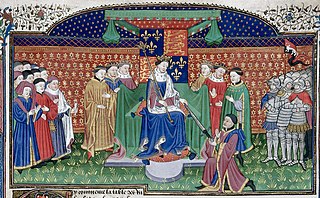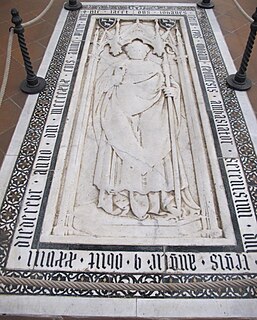Related Research Articles
Simon de Langham was an English clergyman who was Archbishop of Canterbury and a cardinal.

John Stafford was a medieval English prelate and statesman who served as Lord Chancellor (1432–1450) and as Archbishop of Canterbury (1443–1452).
Marmaduke Lumley was an English priest, Bishop of Carlisle from 1429 to 1450, and Knight Commander of the Order of St. John of Jerusalem. He was a son of Ralph de Lumley, 1st Baron Lumley and Eleanor de Neville. He was elected about 5 December 1429, and consecrated on 16 April 1430. He was Bishop of Lincoln for a short time before his death in December 1450. He was educated at University of Cambridge and was appointed Precentor of Lincoln Cathedral in 1425. He also became Chancellor of the University of Cambridge in 1427 and was Master of Trinity Hall, Cambridge from 1429 to 1443. From 1446 to 1449 he served as Lord High Treasurer of England. Lumley's tenure as Lord High Treasurer occurred during the Great Bullion Famine and the Great Slump in England.
William Senhouse, also called William Sever, was an English priest, successively Bishop of Carlisle, 1495–1502, and Bishop of Durham, 1502–1505.
Thomas Brunce was a 15th-century Bishop of Rochester and then Bishop of Norwich.
John Fordham was Bishop of Durham and Bishop of Ely.

John Barnet was a Bishop of Worcester then Bishop of Bath and Wells then finally Bishop of Ely.
Nicholas Bubwith (1355-1424) was a Bishop of London, Bishop of Salisbury and Bishop of Bath and Wells as well as Lord Privy Seal and Lord High Treasurer of England.
Robert Reed was a Bishop of Waterford and Lismore, Bishop of Carlisle and Bishop of Chichester.
Thomas Polton was a medieval Bishop of Hereford, Bishop of Chichester, and Bishop of Worcester.
John Burghill was a medieval Bishop of Llandaff and Bishop of Coventry and Lichfield.

John Catterick was a medieval Bishop of St David's, Bishop of Coventry and Lichfield, and Bishop of Exeter.

Richard Redman was a medieval Premonstratensian canon and abbot of Shap Abbey, Bishop of St Asaph, Bishop of Exeter, and Bishop of Ely, as well as the commissary-general for the Abbot of Prémontré between 1459 and his death.
John Gilbert was a medieval Bishop of Bangor, Bishop of Hereford and Bishop of St. David's.
Richard de Wentworth was a medieval Bishop of London.
Thomas Hemenhale was a medieval Bishop of Norwich-elect and then Bishop of Worcester.

John Low or John Lowe was a medieval Bishop of St Asaph and Bishop of Rochester, in England.

Richard FitzJames was a medieval Bishop of Rochester, Bishop of Chichester and Bishop of London.
Eadmund was a 9th-century Englishman. It had been thought he had been Bishop of Winchester between 833 and 838. However, following further studies he is no longer listed to have been bishop.
Henry Wakefield was a medieval Bishop of Worcester.
References
- Fryde, E. B.; Greenway, D. E.; Porter, S.; Roy, I. (1996). Handbook of British Chronology (Third revised ed.). Cambridge, UK: Cambridge University Press. ISBN 0-521-56350-X.